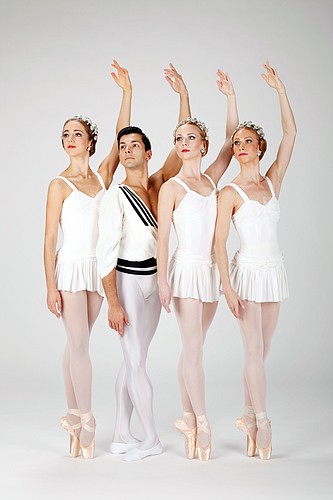- May 3, 2025
-
-
Loading

Loading

The Sarasota Ballet opened its 22nd season with a diverse program of styles of dance and music, once again proving that Director Iain Webb is a master at programming triple-bill performances that each offers something to please every audience member’s tastes. The program included Sir Frederick Ashton’s “Symphonic Variations,” Christopher Wheeldon’s “There Where She Loves” and Paul Taylor’s “Company B.”
The performance opened with a video of Webb interviewing Wendy Ellis Somes, who owns the rights to Ashton’s “Symphonic Variations” and set the ballet on the company. Somes explained Ashton’s inspiration for the scenery and how he found César Franck’s music during World War II, thus setting the tone of the ballet to be one of new beginnings. Somes also spoke of Ashton’s wishes to always have “Symphonic Variations” be the second piece on the bill and how it was a unique occasion for the piece to be performed first.
The ballet is a neoclassical piece featuring six dancers — three women and three men — who intertwine with interesting formations and a mixture of sharp lines and soft movement. The six dancers required an exorbitant amount of energy, because they never left the stage while striving to dance in unison and with musicality. Ellen Overstreet, one of the newest members of the company, was one of the three women with principals Danielle Brown and Victoria Hulland. Overstreet has an amazing facility with long lines and beautiful feet, but her youthfulness was apparent next to the mature performing abilities of Brown and Hulland.
Not only is Wheeldon’s “There Where She Loves” a gorgeous and moving piece, but it was exceptionally delightful to see it performed with the live music of Frédéric Chopin and Kurt Weill by musicians Stella Zambalis, mezzo soprano, Michelle Giglio, soprano, and Jonathan Spivey, pianist. The piece depicts moments of love, loss and betrayal through the perspective of women. Christine Peixoto was a true standout in this piece. The choreography accentuated her incredible extensions and flexibility as well as her emotional grasp of the piece. Peixoto was partnered by four men in a series of multiple lifts that were executed effortlessly.
The piece ended with a passionate pas de deux with Amy Wood and Ricardo Graziano. As the title of the scene, “Je ne t’aime pas,” suggests, the duet displayed the tumultuous relationship with choreography that pulled the pair apart, but forced them back together again. Wood and Graziano expertly captured the essence of this piece.
The program ended with another war-themed piece, Taylor’s “Company B,” which is set to the music of The Andrews Sisters. It combined upbeat rhythms and solemn subtle messaging in the background. The entire company performed the Taylor style with precision, which was evident in the group segments, and the dancers appeared to be having a lot of fun dancing the modern choreography. The company looked like a true modern troupe and not a group of ballet dancers trying to grasp the modern technique.
Surely an audience favorite, “Company B” included 10 different vignettes, including “Tico Tico” that showcased the talent of Simon Mummé. Mummé dazzled with leaps, rolls and flips. Kristianne Kleine was beautiful in “I Can Dream, Can’t I,” showcasing a softer and more lyrical side to her dancing. Logan Learned blew the audience away with his rendition of “Boogie Woogie Bugle Boy (of Company B).” And Kate Honea and Jamie Carter stunned in “There Will Never Be Another You,” a moving pas de deux that solidified the entire piece.